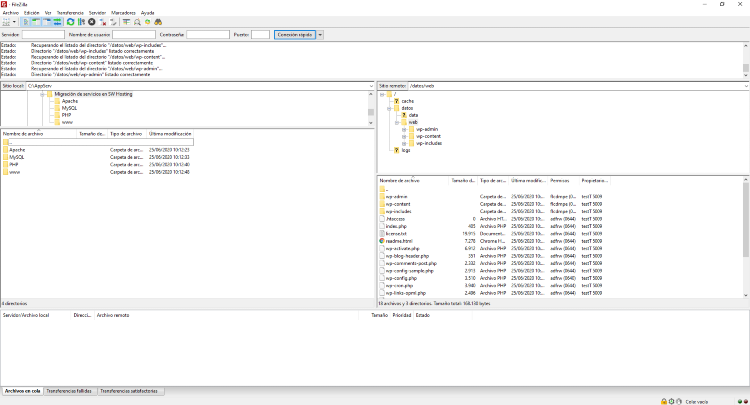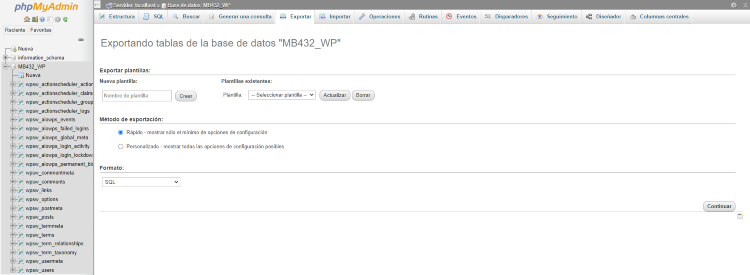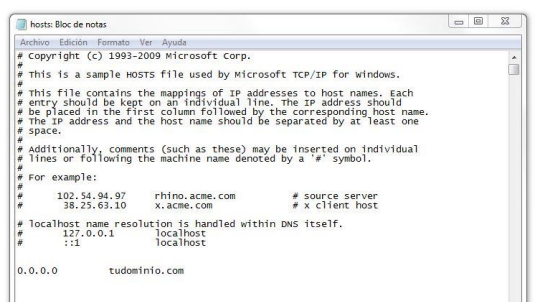Migration of services in SW Hosting
A migration consists of moving the database, FTP and mail content from your current server to another server, either from the same provider or from another one.
Prerequisites
To avoid possible compatibility problems you must take into account different points:
If your website is developed in PHP or HTML you will need a LAMP platform (Linux, Apache, MySQL and PHP). If on the other hand it is in ASP/.NET you will need a Windows environment.
The language versions will have to match to avoid functionality problems or errors on the web. In any case, you must make sure that they are compatible.
Before starting the migration, you must hire the Cloud server or Hosting that meets the necessary requirements for the operation of your website, with sufficient resources and disk space needed to perform the migration. You can get more information on our website about the services we offer at www.swhosting.com.
Below, we will outline one by one all the necessary steps to complete the migration:
Step 1 : Gather all the necessary data.
You will need to collect from your current provider, the access data for different functions:
1. FTP account data: FTP data
You can easily get the FTP Data from your SWPanel, as explained in the FTP account management manual. If you cannot find them you can always create a new additional FTP account.
You should also be interested in knowing the public folder of the service, usually www/htdocs/ or web/ . If you can't find it, you can view it through our SWPanel.
2. Data of the data base (BBDD):
In order to continue you need to have the server, the name of the database, user and password access. Normally, an access to phpMyAdmin is also provided to facilitate the management.
3. POP or IMAP access data to your e-mail:
This data can be found in the email section, as explained in the email manual or you can request it from your current provider or through our Free Support.
The mail server name usually has a nomenclature similar to "pop3.yourdomain.com" or "imap.yourdomain.com" depending on the protocol you are using. The user name is usually that of the same email account, for example it could be "[email protected]". On the other hand, if you do not remember the password, you can always generate a new one.
Step 2 : Download your website via FTP
In this step you have to connect to your server using an FTP client such as Fillezilla indicating the server name, username and password, as explained in the FTP account management manual. Once you have access, download all the files and directories to your computer, usually accompanied by a log folder.

Step 3 : Export your MySQL databases
Log in to the database server. Use the phpMyAdmin address and enter the server name, username and password. Select the database you want to export and download it in a SQL (.sql) file and upload it to the new server.

Step 4 : Download your emails
Make sure that all your emails are downloaded using the POP3 protocol with a mail manager such as Outlook, Thunderbird or Mail. This way you will have a copy of all your emails received to date.
Step 5 : Activate the new services
In this step you must register the new services in your SWPanel. This includes creating the FTP account, the new database and the creation of all the email accounts.
You can search our manuals or contact our Support team for any questions about FTP account setup, email or database creation and their associated users.
FTP account setup manual
Manual how to create a mailbox from SWPanel
How to create a MySQL or MariaDB database
Step 6 : Upload the website and the DB to the new server
1:
Connect to the new FTP account and upload the files and directories of your website that you had previously downloaded.
2:
Log into phpMyAdmin and import the database .sql file. You may have to modify the configuration file on your website with the new connection data.
To verify correct operation, you can modify the host file on your computer to point to the new server IP. IIn Windows you can find it in a line following the format, with the IP of the new server and the domain.
This way you can make sure that everything works correctly.

Step 7 : Revision and startup
If the website is working as expected, the only thing left to do is to modify the DNS of your domain with the DNS provided by SWHosting.
The propagation of the DNS can take between 24/48 hours. During the process, the email will work with the previous data until the DNS propagation is effective. At this moment the emails will be received in the new account created and you will have to modify your email manager with the new data.


